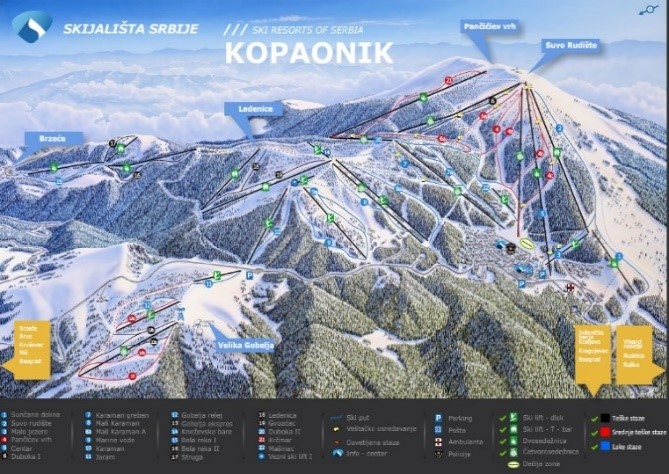Institution/Author: University Singidunum/ dr Lidija Amidžić
The National Park “Kopaonik” occupies an area of only 11 969. 04 ha. One of the threats for biodiversity in the National Park “Kopaonik” is fragmentation and degradation of natural habitats due to the development of tourist infrastructure and the expansion of construction zones. Especially vulnerable is the zone of subalpine communities of spruce and high mountain pastures. The consequences of anthropogenic pressures on wild species and gravel habitats are already visible since disappearance of certain species in Kopaonik is recorded such as brown bear (Ursus arctos), lynx (Lynx lynx), chamois (Rupicapra rupicapra), western capercaillie (Tetrao urogallus), roller (Coracius garrulus ), griffon vulture (Gyps fulvus), chough (Pyrrocorax graculus), booted eagle (Hieraaetus pennatus), billed Chough (Pyrrocorax pyrrocorax), wallcreeper (Tichodroma muraria), etc.
According to the Spatial plan of the special purpose area of the National Park “Kopaonik” (Official Gazette of RS, No. 95/09), construction land occupies a total of 401.1 ha, while the construction areas under the infrastructure (tourism, transport, water, energy and telecommunication) are much broader. All construction areas including those under infrastructure are mostly located in the buffer zone of the National Park and in the zone under the protection regime of 3rd degree, and to a lesser extent in the zone under the 2nd degree protection regime. Buffer zone is the area outside the borders of protected area, important ecological area and/or ecological corridor which may be defined when such areas are established, in order to prevent, i.e. mitigate external impacts.
The following protection regimes are established in protected areas:1) 1st degree, 2) 2nd degree and/or 3) 3rd degree.
1st degree protection regime – strict protection, is implemented in protected area or part thereof with original or slightly changed ecosystems of exceptional scientific and practical importance, which enables processes of natural succession and conservation of habitats and life communities in wilderness conditions.
2nd degree protection regime – active protection, is implemented in protected area or part thereof with partially changed ecosystems of high scientific and practical importance and particularly valuable landscapes and geo heritage objects.
3rd degree protection regime – proactive protection, is implemented in protected area or part thereof with partially changed and/or changed ecosystems, landscape and geo-heritage objects of scientific and practical importance.
The main alpine ski slopes (without connecting trails, which cover around 50 % of the length of the main trails and about 30 % of their surface) are planned in total length of around 190.5 km on an area of around 955 ha, of which around 128 km and 640 ha in the territory of National Park (64.3 ha in the zone of 2nd protection degree and 575.7 ha in the zone of 3rd protection degree and 282.5 ha in the buffer zone). The average of ski slope through the forest will amount to around 179 ha in the area of National Park. There are 47 795 skiers in this area which besides the total infrastructure represents an extremely strong pressure on biodiversity.

Table: Surface structure according to Protection regimes
| National Park “Kopaonik” | ||
| Surface structure according to Protection regimes | ha | % |
| Protection regime of 1st degree | 1 477.79 | 12 23 |
| Protection regime of 2nd degree | 3 604.74 | 29 84 |
| Protection regime of 3rd degree | 6 886.51 | 57 93 |
| Total surface | 11 969.04 | 100% |